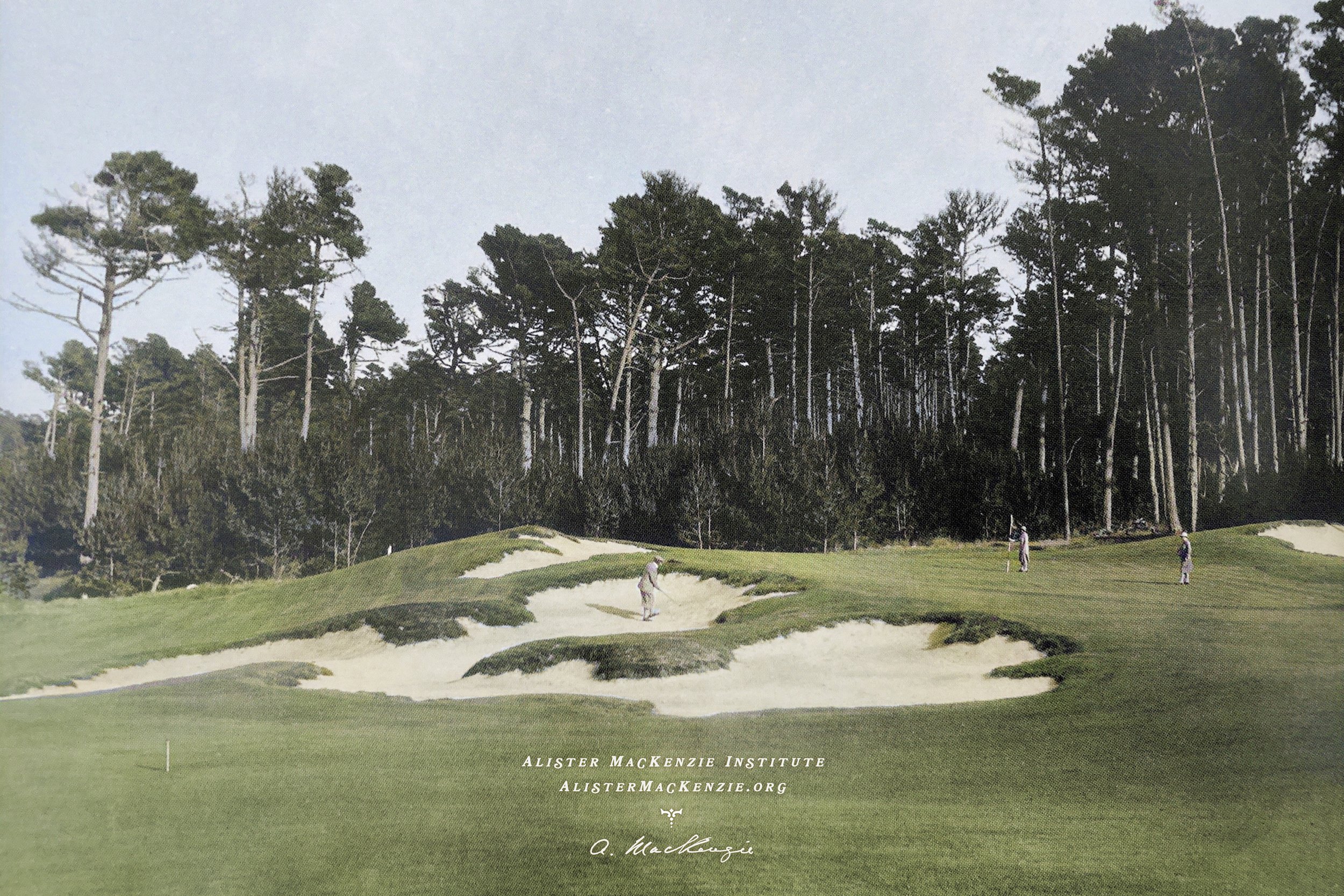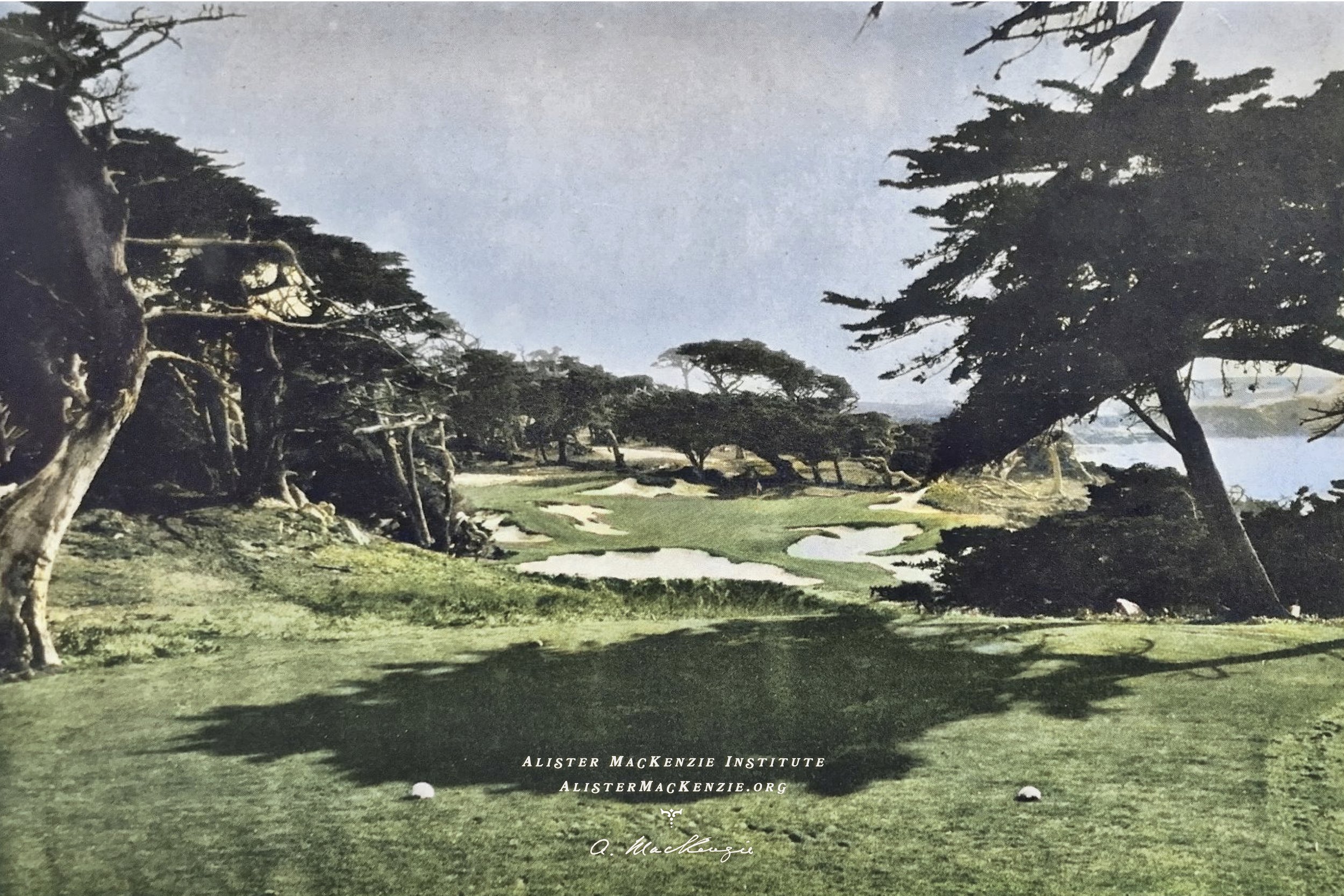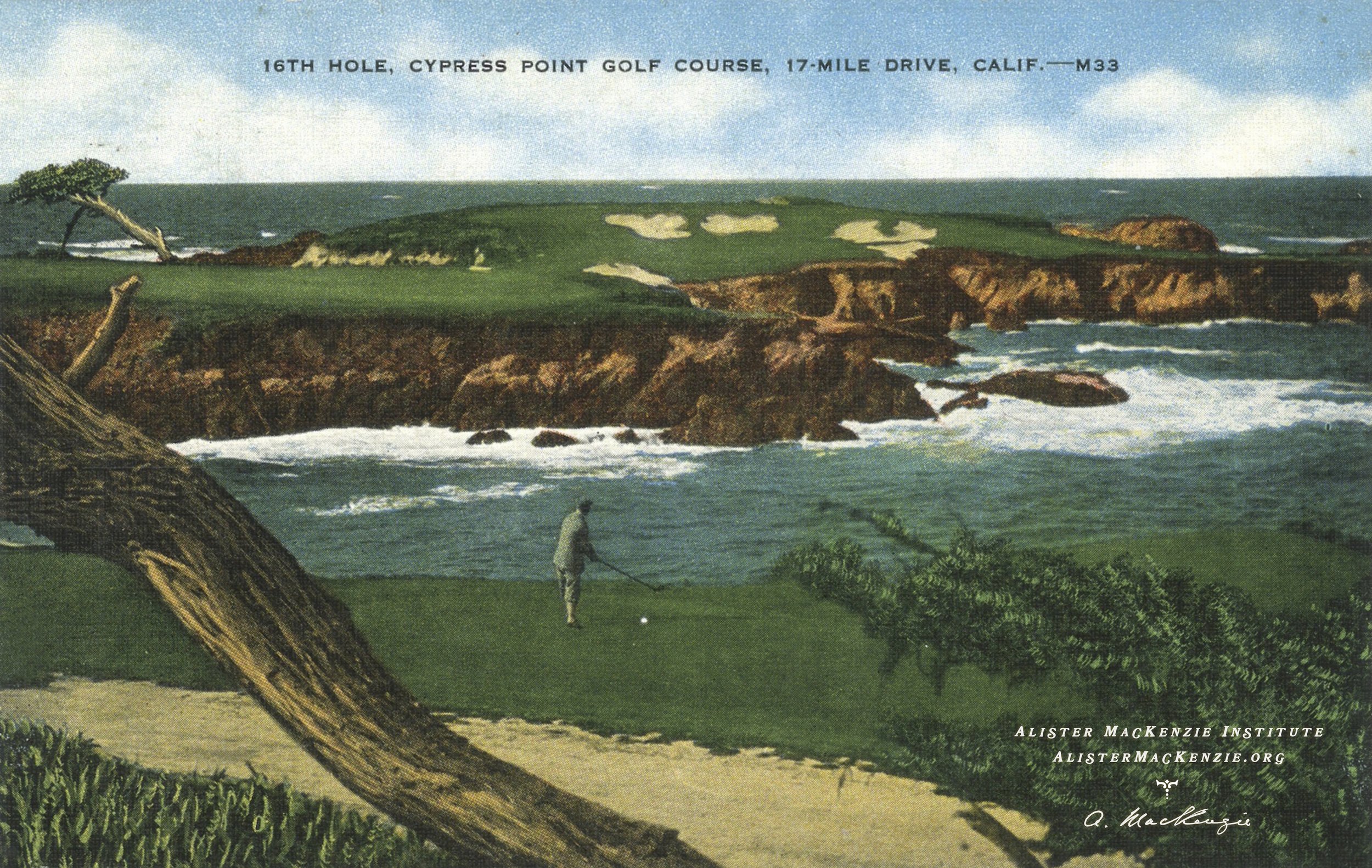CYPRESS POINT GOLF COURSE
Has Similar Strategic Problems to St. Andrews and
Is Infinitely More Spectacular and Beautiful
By DR. ALISTER MACKENZIE
THE FAIRWAY - SAN FRANCISCO
NOVEMBER 1928
:::
IN JANUARY of this year on my way to California I lunched with Mr. Alan Wilson, a prominent member of Pine Valley and Merion Golf Clubs and a keen student of golf course architecture. He suggested that when I was in California I should visit a place called Cypress Point on the Seventeen-mile drive of the Del Monte Peninsula.
He stated that there I would find real links land which in its marvelous beauty and magnificent golfing features excelled not only our British championship courses, but anything else in the world.
I was pleased to be able to tell him that I had already made two visits to California for the purpose of preparing plans for a golf course at Cypress Point and that I was on my way out for the third time to supervise the finishing touches of the construction work. Cypress Point has exceeded our most sanguine expectations.
The putting green of the Second hole on the Cypress Golf Club course, near Del Monte. This green was built on featureless ground having a clay soil. Yet it may be noted that the contours of the green and the placing of the bunkers give a very natural appearance. The ensemble blends in nicely with the setting. — J. P. Graham Photo
Not only is it the best golfing terrain I have ever had to deal with, but it is the only course I have ever been associated with which has given me complete satisfaction in regard to the details of the construction work.
The world’s greatest artist would find it impossible to tell where nature ended and artificiality commenced. This is so much the case that most golfers will think that the architects have simply chosen the obvious places for greens that nature has designed for them. Perfection in the imitation of nature is the real test of first-class construction work. At Cypress Point it is difficult to realize that most of the bunkers have been artificially created and all the greens and fairways have been artificially contoured.
The formation of the club was due to the energy and foresight of Miss Marion Hollins. Miss Hollins has a flair for discovering ideal golfing sites. She was the founder of the American Women’s National and has recently discovered a magnificent site for a golf course at Santa Cruz as a seaside resort.
The Home Hole at Cypress Point. Left to right, the foursome is composed of Dr. A. MacKenzie and Robert Hunter, co-architects of the Cypress Point layout; G. C. Cassles, manager London branch, Bank of Montreal, and the fourth member, J. H. Beckerton, Royal Air Force, can be seen playing a difficult shot from the base of a tree, to the right of where caddie is headed toward the woods. — J. P. Graham Photo
In the design and construction of Cypress Point I was fortunate in being associated with Mr. Robert Hunter, the author of “The Links,” which is by far the best book on golf architecture ever written.
As an example of the time and thought he devoted to the course, he sent me ten pages of typewritten memoranda on problems connected with the soil, fertilizers, seed, drainage, etc., for my consideration and comments. Before seeding commenced, he had several experimental plots to test out the germination of different kinds of seed and the effect of fertilizers, chemicals, different kinds of soil, etc., on their growth.
The perfection of the greens and fairways which already (less than a year from the time construction work commenced) equal any in Europe or America, is undoubtedly due to Mr. Robert Hunter.
He is chairman of the green committee and as long as he remains in control of the green, members may be assured that the course will retain its already high pitch of perfection.
The Sixteenth at Cypress Point, destined to become the most famous one-shot hole in America. As you take your stance you look straight across an abyss 100 yards wide. Below and to the left is a sandy beach. You may carry this beach with a short drive and then pitch to the green, which lies at the very end of the point, surrounded on three sides by the sea. But to do so means to play for a four, and par is three. The par shooter must turn from the beach towards the sea. The breakers wash the beach in the sandy cove, and beyond these breakers there extends out into the water a rugged arm of the peninsula. Beyond this arm another cove cuts into the cliff and, beyond that, the green. To reach the green in one shot you must carry the first cove, the jagged arm and the second cove. This requires a sheer carry of 210 yards. — J. P. Graham Photo
The construction work was carried out by the American Golf Course Construction Company, of which Mr. Robert Hunter, Jr., is managing director. He took the trouble to retain from Britain two excellent foremen — Dan Gormley and Jack Fleming, who had years of training in the construction of golf courses designed by me.
At first sight it might be considered that the combination of architect and contractor might increase the cost of the course. This has not been the case. On the contrary, the course has cost much less than anticipated. On condition that we could choose the construction company, we estimated the cost at $100,000. It was suggested that we were unduly optimistic. We were told that other experts had been consulted and the lowest estimate of cost had been $150,000. We still persisted in our view that the most spectacular golf course in the world could be constructed for $100,000. This estimate included all construction work, complete underground irrigation system of all the fairways, greens and tees, seeding, manuring and soiling about forty acres of sand dunes and woods, and the uprooting of twenty acres of dense pine woods.
We not only completed the whole course for $90,000, but did a great deal more work than we undertook to do.
We removed about fifteen acres more of trees than were necessary from a golfing point of view, for the purpose of opening out fresh vistas to the ocean and sand dunes, and increasing the beauties of the place. We constructed more than twice the number of tees agreed upon. We mad watered grass tracks from the greens to the tees, and from the tees to the fairways. We enlarged the fairways towards the tees, so that nowhere would the dub have a compulsory carry of more than 80 yards.
We also planted many acres of sand dunes with grass, etc., to prevent the sand blowing.
We added every conceivable luxury, such as drinking fountains, in all the shaded places.
How did we manage to do all these things at so much less than the estimate, and at the same time attain such a high degree of perfection? The explanation is a simple one. We adopted to an intensive degree the methods which have made the wealth of America the envy of the world. We displaced much of the excessive cost of manual labor by the comparatively-speaking low cost of mental labor. We had chemists to analyze the varying soil of the sites of fairways and greens and to advise us how to obtain the highest degree of fertility at the lowest cost. We had a botanist to investigate all the natural grasses so as to guide us in the choice of seeds most suitable to the locality. We had every sample of seed tested by at least two independent experts. We obtained guarantees that the seed supplied would correspond with the samples. We used varying mixtures of seed on different fairways. We purchased all pipes, fittings, and other goods direct from the wholesale merchants. We consulted the highest engineering experts in regard to drainage and irrigation problems. We sought the advice and guidance of the Advisory Section of the U. S. Golf Association on every conceivable problem.
The trained foreman insured that there would be no lost motion in carrying out the details of the construction work and, above all, we insisted that no work should be done by hand that could be done cheaper by machine.
The Fifteenth is the most picturesque hole on the Cypress Point course and many consider it the most beautiful green they have ever seen. Par is three and the distance is 130 yards from the back tee. You must carry a cove that juts in with all the terrifying aspect of a ragged barranca. You will observe the gray spar of a wrecked ship piled up on the beach in this little inlet — and pray that your ball does not pile up there also, to wreck your hopes. The green is woven among islands and points of sand. Beyond and to the left lies the forest of cypress. — J. P. Graham Photo
In constructing Cypress Point we had the greatest help from the members of the committee, consisting, among others, of Messrs. Van Antwerp, Roger Lapham, Jimmy Mackenzie and Chandler Egan. The gave us everything we asked for, but at the same time told us that we had an absolutely free hand and all the responsibility for success or failure was entirely in our hands. It is unnecessary for me to give a description of the hole at Cypress Point, as this has already been done by Robert Hunter in a much more vivid and graphic manner than I can hope to aspire to.
The lengths of the holes are as follows:
Championship Course
1 445
2 565
3 160
4 420
5 476
6 515
7 170
8 360
9 320 — 3441 OUT
Championship Course
10 475
11 450
12 420
13 400
14 420
15 130
16 350
17 420
18 365 — 3430 IN
Total 6871 YARDS
Short Course
430
520
150
380
330
475
165
310
270 — 3030
Short Course
475
400
320
340
390
90
240
370
320 — 2945
5975
Regular Course
430
550
150
380
466
490
165
340
270 — 3241
Regular Course
475
420
395
380
390
110
240
390
335 — 3135
6376
This aeroplane view of the proposed course was drawn by Albert Barrows from the sketches and plans prepared by Dr. MacKenzie. Although reproduced on a small scale, the reader can get a very good idea of the unexampled terrain surrounding the various holes.
The fairways of the holes from the First to the Fifth lie almost wholly within the confines of the forest. From the Sixth tee the player drives directly into the face of one of these magnificent white mountains of sand. The holes from the Seventh to the Thirteenth are played directly in the dunes and thereby exactly reproduce the conditions found in the famous seaside championship links of Great Britain.
The Fourteenth, starting the player on the edge of the sand dunes, takes him directly along the edge of the forest into a green situated within a stone’s throw of the ocean spray. It is hard to avoid superlatives in describing this course but certainly the next three holes are spectacular and bold beyond all imagining.
The course is very elastic as there is a forward walk to nearly every tee. It can be lengthened still further if desired in the future. It shares with the old course at St. Andrews the distinction of being just as pleasurable to the dub as the scratch man — at no place is there a compulsory carry of more than 80 yards, but at many holes there are voluntary carries of 200 to 250 yards tempting the long drivers to great rewards.
Bobby Jones has described the old course at St. Andrews as not only the best in the world, but that more value is obtained on one round of it than on one hundred other golf courses.
Cypress Point has similar strategic problems to St. Andrews and is infinitely more spectacular and beautiful.
For years I have been contending that in our generation no other golf course could possibly compete with the strategic problems, the thrills, excitement, variety and lasting and increasing interest of the old course, but the completion of Cypress Point has made me change my mind.
Postcard of Dr. Alister MacKenzie teeing off on the picturesque Sixteenth hole at Cypress Point. — Courtesy of the Alister MacKenzie Institute






